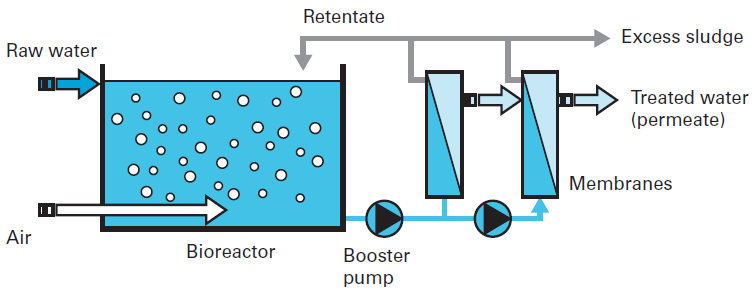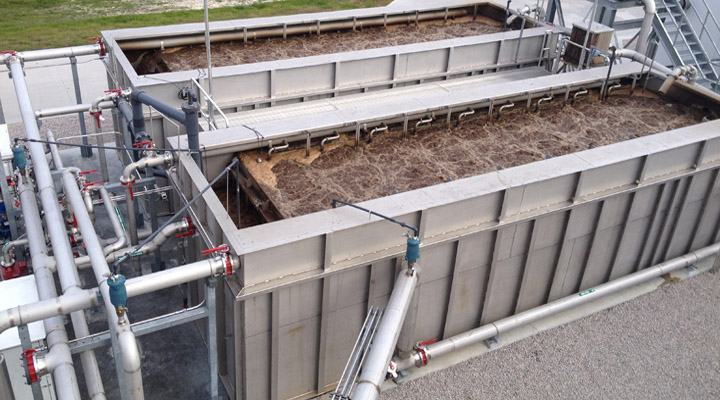How Membrane Bioreactor Can Help Meet Stringent Environmental Regulations
Wiki Article
Recognizing Membrane Layer Bioreactors: The Future of Wastewater Therapy
Membrane bioreactors (MBRs) represent a notable innovation in the area of wastewater therapy, incorporating biological processes with sophisticated membrane filtration to enhance effluent quality. As worldwide water deficiency and stringent governing frameworks come to be progressively pressing issues, MBR innovation provides a reliable action via its capacity to minimize footprint and maximize source healing. Nonetheless, the adoption of MBRs is not without its challenges, which warrant cautious consideration. What are the crucial variables affecting their implementation and long-term viability in different contexts? The answers may improve our method to wastewater management.What Are Membrane Bioreactors?

The core components of MBR systems include a bioreactor where microbial task occurs and a membrane layer system that filters the combined alcohol. This dual functionality makes it possible for the simultaneous deterioration of natural issue and solid-liquid splitting up in a solitary action. MBRs can run in both immersed and external arrangements, with submerged systems being more common as a result of their portable design and functional performance.
The fostering of MBR modern technology has gotten traction in different applications, varying from community wastewater treatment to commercial effluent administration. MBRs are particularly beneficial in scenarios where area is stringent or restricted effluent high quality requirements must be satisfied. By maintaining a high focus of microbes within the bioreactor, MBRs boost the degradation of natural toxins, therefore generating greater treatment performances contrasted to traditional approaches.
Trick Benefits of MBR Technology
The combination of organic therapy with membrane filtering in MBR systems offers many advantages that set it aside from typical wastewater therapy techniques. One of the key benefits is the boosted effluent top quality. MBRs effectively eliminate suspended pathogens and solids, achieving higher levels of filtration that satisfy strict discharge criteria and facilitate water reuse applications.
One more considerable advantage is the lowered sludge production. MBR systems create much less excess sludge, bring about lower disposal expenses and a decline in environmental effect. The shut nature of the membrane layer system decreases the threat of odor exhausts and improves total process control.
Lastly, MBRs are functional and versatile, making them ideal for various wastewater kinds, including commercial and metropolitan resources. The capability to integrate with sophisticated therapy modern technologies better improves their performance, making MBRs an appealing option for the future of wastewater management.
Obstacles and Limitations of MBRs
While MBR innovation provides many benefits, it additionally deals with several obstacles and restrictions that can impact its widespread adoption. One significant obstacle is the high funding and operational expenses connected with MBR systems. The preliminary financial investment for membrane layer materials and the essential infrastructure can be significant, making it much less easily accessible for smaller communities or markets.Furthermore, membrane fouling stays a vital issue that can diminish system efficiency and rise upkeep demands. Fouling occurs when solids, raw material, or bacteria collect on the membrane layer surface area, leading to lowered permeability and calling for regular cleaning or replacement.
An additional restriction involves the complexity of the technology. MBR systems call for skilled workers for operation and upkeep, which can be an obstacle in areas with minimal technical proficiency. Moreover, the disposal of invested membranes presents ecological worries, as the materials are usually not naturally degradable and can contribute to lose monitoring difficulties.
Lastly, while MBRs can properly deal with a wide variety of wastewater, they may not be suitable for all applications, particularly those with high focus of fats, oils, and greases, demanding additional research and technology to address these constraints.
Applications of Membrane Bioreactors
In different sectors, membrane layer bioreactors (MBRs) have actually become a site link flexible option for wastewater therapy (Membrane Bioreactor). Their applications cover metropolitan, commercial, and agricultural setups, showcasing their versatility and effectiveness in varied settings. In municipal wastewater treatment plants, MBRs substantially improve effluent quality, enabling water reuse and minimizing the environmental impact of discharged wastewaterIndustrially, MBRs are employed in food and beverage processing, textile manufacturing, and pharmaceutical production, where they properly treat high-strength waste streams. Their capacity to deal with differing and changing loads pollutant focus makes them especially important in these markets. In addition, MBRs facilitate the elimination of pathogens, put on hold solids, and natural issue, adding to compliance with strict discharge policies.
In farming, MBRs are progressively utilized for dealing with farming overflow and livestock wastewater, allowing the healing of nutrients for plant food manufacturing. They likewise aid in the therapy of greywater for watering, advertising sustainable water management methods.
The adaptability of MBRs is additional shown by their integration with various other modern technologies, such as anaerobic food digestion and progressed oxidation procedures, boosting total efficiency and resource recuperation in wastewater therapy systems.
The Future of Wastewater Treatment
Improvements in innovation and a growing focus on sustainability are forming the future of wastewater therapy. Membrane layer bioreactors (MBRs) exemplify see this website this change by integrating organic treatment processes with membrane layer filtering, resulting in high-grade effluent suitable for reuse. The fad towards round economic climates is triggering centers to adopt MBRs for their capability to recuperate sources, such as water and nutrients, from wastewater.Advancements in membrane products and configuration are enhancing the efficiency and longevity of MBR systems, lowering functional prices and energy usage. Smart modern technology combination, consisting of real-time monitoring and automated control systems, is more enhancing efficiency and enabling anticipating upkeep, thus minimizing downtime.
In addition, governing pressures and societal assumptions are pressing industries and districts to take on even more lasting practices. Membrane Bioreactor. The change towards decentralized wastewater therapy options is acquiring grip, enabling localized treatment that minimizes transportation costs and power usage
Conclusion
Membrane bioreactors (MBRs) represent a transformative technique to wastewater treatment, website link integrating organic procedures with innovative membrane layer innovation. The advantages of MBRs, consisting of enhanced effluent quality, reduced spatial demands, and lower sludge production, position them as a viable solution in the middle of growing urbanization and more stringent ecological guidelines. Regardless of existing obstacles, the ongoing development in membrane layer products and functional methods promises to bolster the effectiveness and adoption of MBRs, guaranteeing their critical duty in the future of lasting wastewater monitoring.Membrane bioreactors (MBRs) stand for a notable innovation in the field of wastewater therapy, incorporating biological procedures with advanced membrane layer filtration to boost effluent high quality.Membrane bioreactors (MBRs) incorporate organic therapy processes with membrane layer filtration to effectively deal with wastewater.The assimilation of biological therapy with membrane layer purification in MBR systems provides many benefits that set it apart from traditional wastewater treatment techniques. Membrane bioreactors (MBRs) exhibit this change by incorporating biological treatment procedures with membrane layer purification, resulting in high-quality effluent appropriate for reuse.Membrane bioreactors (MBRs) stand for a transformative method to wastewater treatment, integrating organic procedures with innovative membrane innovation.
Report this wiki page